Growing Up in Scotland: Birth Cohort 2. Results from the First Year
This Growing up in Scotland report provides a detailed insight into the first set of data collected from the study’s second birth cohort – representative of all children born in Scotland between 1st March 2010 and 28th February 2011 – around the time they were all aged 10 months old.
Chapter 9 Child health and development
Catherine Bromley, Centre for Population Health Sciences, University of Edinburgh
9.1 Introduction
As noted in the report introduction, Scotland has a large number of policies and targets, covering a wide range of areas, designed to promote children's health, development and wellbeing. Despite their broad range (see examples below), these various initiatives and policies all share the common aim of maximising children's early potential by providing them with the best start in life. One of the core principles of the Getting it Right for Every Child (GIRFEC) approach[27] - is a commitment to child wellbeing. Two of the eight basic requirements for wellbeing set out in GIRFEC are particularly relevant to this chapter:[28]
Healthy - having the highest attainable standards of physical and mental health, access to suitable healthcare, and support in learning to make healthy and safe choices;
Achieving - being supported and guided in their learning and in the development of their skills, confidence and self-esteem at home, at school and in the community.
The GIRFEC principles and approach are further supported by the Early Years Framework,[29] and the Scottish Government's commitment to children's health and development is further underlined by the National Performance Framework[30] which includes outcomes focused both on children and health.
For Scottish Government, these all acknowledge the importance of, and need for, effective interventions in the early years. Scotland's Chief Medical Officer made his views on this matter clear with the statement: "…a healthy childhood is the foundation of a healthy life"[31].
The potential for intervention in the early years to have a positive impact on immediate outcomes, as well as to reduce health inequalities in later life, has global recognition, for example via the report for the WHO's 2008 Commission on the Social Determinants of Health (Irwin, Siddiqi and Hertzman, 2007), and the October 2011 Rio Political Declaration on the Social Determinants of Health (coordinated by the WHO)[32]. Tied to this, the evidence that very early brain development includes various 'sensitive periods' in which it is optimal to acquire key cognitive, social and emotional skills, has been a very powerful policy lever with the corresponding implication that delays in these periods are difficult (though not impossible) to modify (McCain and Mustard, 1999).
There are many specific examples of the ways in which the above principles are being operationalised in Scotland. The following illustrations have been selected to highlight aspects of direct relevance to the results presented in this chapter. It is not, by any means, an exhaustive list.
For example, there is the high-level commitment to increasing the proportion of children born with a healthy weight;[33] pilot schemes across Scotland testing the Family Nurse Partnership approach which provides first-time mothers under 20 with a dedicated nurse to support them from pregnancy until their child reaches the age of 2;[34] comprehensive information resources for pregnant women and new parents via the Ready Steady Baby programme;[35] an awareness-raising initiative to promote the importance of interacting with babies and toddlers to help their cognitive and social development;[36] direct interventions to improve dental health in the pre-school years via NHS HEAT targets[37] and the Childsmile initiative;[38] and targeted campaigns to raise awareness about potential accident risks for young children[39].
Alongside these kinds of initiatives to promote health and improve outcomes for children, Scotland's pre-school child health surveillance programme monitors children's early health and development and provides an opportunity for problems to be identified and appropriate interventions implemented[40]. At present, this system combines a series of universal screening tests and reviews (predominantly in the neo-natal period), and an immunisation programme, complemented by more intensive monitoring of some children if a health visitor judges this to be necessary[41]. For example, around the age of 2 years, the carers of children who are receiving additional monitoring from health visitors participate in a review of their child's development, during which details of the child's progress with motor skills and communication are recorded. Following a review of this approach, in April 2010 the Scottish Government Health Directorate issued updated guidance to all Health Boards stating that a 24-30 month developmental review should be conducted with all children (Scottish Government, 2010). The contents of the review were prepared by a working group, subject to consultation and guidance, and published in December 2012 (Scottish Government, 2012). The new reviews will be offered to all children aged 27-30 months and are due to be implemented across Scotland from April 2013. They will focus on socio-emotional and language development, child healthy weight, parenting and family wellbeing.
This chapter covers a number of areas that relate directly to the points discussed above. Where available, comparisons are made with the results from the first GUS birth cohort, conducted in 2005/06. Variations in children's health and development are explored in relation to a number of factors, such as the child's sex and their family's socio-economic circumstances.
The following areas of child health and development will be addressed in turn:
- Children's general health (as assessed by their carers), long-term conditions and health problems experienced in the first year of life
- Accidents requiring treatment from health professionals, including those resulting in hospital visits and admissions
- The acquisition of motor skills and early communicative behaviour is therefore covered in some detail
- Parental knowledge of early child development and concerns about development. Sleep patterns, duration and parental reports of problems with sleep
- Tooth-brushing habits
- Child temperament
9.2 Key findings
- 95% of children in 2010/11, and 94% in 2005/06, were described by their main carers as having 'very good' or 'good' health. In 2010/11, 79% of children in one child households had 'very good' health, this declined to 70% in households with four or more children. 78% of children in the two least deprived quintiles had 'very good' health, compared with 72% in the most deprived quintile.
- 12% of children in 2010/11, and 13% in 2005/06, had a long-term condition or illness. In 2010/11, boys (13%) were more likely than girls (10%) to have a long-term condition or illness. Children born to mothers aged 30 and over (13%) were more likely to than those aged under 30 (10%). 19% of low birthweight children had a long-term condition compared with 11% of those whose birthweight was not low.
- Children in 2010/11 were reported to have experienced a mean number of 2.4 different health problems since birth (aside from long-term conditions or accidents). This was higher in boys (2.6) than girls (2.3). Boys with mothers aged under 20 when they were born were the most likely group to have experienced a higher number of different problems.
- Most parents had contacted someone about their child's health problems: 40% made contact about all of them, 45% about some of them, and just 14% said they had not contacted anyone. 49% of mothers under 20 had contacted a professional about all their child's health problems compared with 38-39% of those born to mothers aged 30-39 and 40 or older.
- In 2010/11, 8% of children (8% of boys and 9% of girls) had received treatment for an accident. This represents a small (but statistically significant) reduction from 2005/06 when 10% of children had done so (11% of boys, 9% of girls). In 2010/11, 13% of children whose mothers were aged under 20 at their birth had received treatment for an accident compared with 6% of children with mothers aged 40 or more. Education level, income and area deprivation were unrelated to accident treatment rates.
- Seven milestones were asked about in the 2005/06 and 2010/11 interviews to assess motor skills development. 17% of children in 2010/11 had missed one of the milestones compared with 20% in 2005/06. Second and subsequent born children were more likely than firstborn children to have missed milestones than firstborn children as were children born to mothers aged 40 or over and those with low birthweight.
- Ten communication behaviours were asked about in the 2010/11 interview. All but one of the behaviours were displayed by the majority of children, with only around a quarter of children able to nod to indicate yes at 10 months. For half of the individual items, girls' communication skills were more advanced than boys, and children in the most deprived areas were more likely to display the behaviour than children in the least deprived areas.
- Compared with the average child, early communication skills were less well developed if a child was not a mother's firstborn, if they lived in the least deprived areas, and if they had a main carer from an ethnic group other than white. Children with delayed motor skills, and those with low birthweights, also had less well developed communication skills.
- Just 5% of carers in 2010/11 reported some or a lot of concerns about their child's development, learning or behaviour. This was a reduction from 8% in 2005/6. 9% of carers in the lowest household income quintile had concerns compared with 4% in the two highest quintiles.
- 4% of main carers whose children had met all of the six motor milestones (described above) reported some concerns, compared with 34% for children missing two or more milestones. The prevalence of concerns was also a little higher for children with the lowest level of communication skills compared with those with the highest level of skills (10% versus 4%). This possibly suggests that delays in motor skill development trigger concerns more readily than problems with communication skills.
9.3 General health, long-term conditions and acute illnesses
9.3.1 General health
The vast majority of children in 2010/11 (95%) were described by their main carers as having 'very good' or 'good' health. The equivalent figure in 2005/06 was 94%. With ratings of health as high as this, the potential for variation across groups was limited. However, differences were evident in the proportions of children with very good health, and, in some cases, the worst health (fair, bad or very bad).
As Table 9.1 shows, girls (77%) were more likely than boys (72%) to have 'very good' health. The proportion with less than good health also increased with rising household size and area deprivation. 75% of children whose main carers described themselves as white had 'very good' health and a further 20% had 'good' health. In contrast, 65% of those from any other ethnic background were described as having 'very good' health and 31% had 'good' health. However, the prevalence of less than good health was similar in both groups. Children in households containing an adult with higher education were the most likely to have very good health (77% did so compared with 72%-74% in other groups), though levels of less than good health did not vary by education level.
Table 9.1 Child general health by sex, household size and ethnic group of main carer
| Child general health | ||||
|---|---|---|---|---|
| Very good | Good | Fair/bad/ very bad | Base: all families | |
| Sex*** | ||||
| Boys % | 72 | 22 | 6 | 3043 |
| Girls % | 77 | 19 | 4 | 3084 |
| All children % | 75 | 20 | 5 | 6127 |
| Number of children in household*** | ||||
| 1 child % | 79 | 18 | 4 | 2814 |
| 2 or 3 children % | 72 | 23 | 6 | 3056 |
| 4 or more% | 70 | 20 | 10 | 257 |
| Ethnic group of main carer*** | ||||
| White % | 75 | 20 | 5 | 5813 |
| Other ethnic group % | 65 | 31 | 4 | 299 |
*** = p<.001
9.3.2 Long-term conditions or illnesses
Main carers were also asked if their child had any physical or mental conditions, or illnesses, that had been present since birth or were expected to last for more than a year (no examples of conditions were provided, but if the carer answered 'yes', then further details were collected and conditions were coded in the office). In 2010/11, 12% of children had a long-term condition or illness, the figure in 2005/06 was 13%. The prevalence of long-term conditions was higher in boys (13%) than girls (10%), and was also higher among children born to mothers aged 30 and over (13%) than those aged under 30 (10%). Unlike general health, the prevalence of long-term conditions did not vary significantly by household size, main carers' ethnicity, educational attainment or area deprivation.
9.3.3 Health problems and treatment
Main carers were shown a list of different health complaints and conditions[42] and were asked to say whether their child had experienced them since birth (long-term conditions already covered in the interview, and accidents/injuries were excluded from this list). Carers were not asked how many times any conditions had occurred so it is unknown whether these were single or recurrent episodes. Children in 2010/11 were reported to have experienced a mean number of 2.4 different health problems since birth (aside from long-term conditions or accidents)[43]. The mean number of different health problems was higher in boys (2.6) than girls (2.3). Despite the fact that children whose main carers were white were more likely to be described as having 'very good' health than children whose main carers were from other ethnic groups, the mean number of different health problems was higher for children of white carers than children of other ethnic groups (2.4 and 2.2 respectively).
Most children will experience health problems at some point in their first year of life. However, by grouping the children according to the number of different conditions experienced it is possible to identify a group whose illness burden is somewhat greater than that experienced by the average child. Figure 9.1 shows the distribution of the number of different conditions experienced, from none to four or more. The rest of the discussion here focuses on the latter group.
Figure 9.1 Number of different health problems experienced since birth (excluding long-term conditions and accidents/injuries), by sex
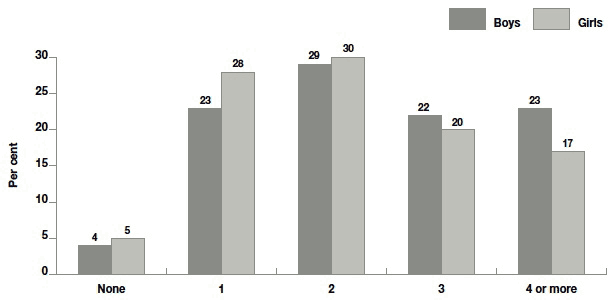
Base - all children: boys = 3043, girls = 3084
As Figure 9.2 shows, boys and girls born to mothers aged 30-39 were the least likely to have experienced four or more different health problems since birth, while boys with mothers aged under 20 when they were born were the most likely. This is unlikely to be an education effect though: 15% of children in households where no one has any qualifications had experienced four or more different health problems, compared with 21-22% of those in households with standard or higher grades, and 19% in households with higher education. Experiencing four or more different health problems was unrelated to area deprivation[44]. The impact of multiple health problems on other developmental outcomes will be explored further below.
Figure 9.2 Proportion of children with four or more different health problems since birth, by maternal age at birth and sex of child
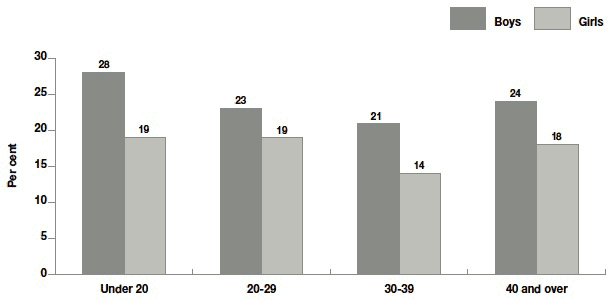
Base - children with four or more health problems: Boys - under 20 = 190, 20-29 = 1274, 30-39 = 1479, 40 and over = 132; Girls - under 20 = 153, 20-29 = 1279, 30-39 = 1471, 40 and over = 135
Following on from the question about different health problems, main carers were asked if they had contacted a health professional about any of the health problems experienced by their child (the options were all, some or none of them). Most parents had contacted someone about their child's health problems: 40% made contact about all of them, 45% about some of them, and just 14% said they had not contacted anyone. As the total number of episodes is unknown (just the number of different conditions/problems), it is easier to interpret the answers of carers who said they made contact about all conditions, or none of them.
As might be expected, the likelihood of making no contact with a professional decreased as the number of problems increased (39% of carers of children with just one health problem did not contact anyone about it compared with 10% of those with two problems, 3% with three problems and 1% with four or more problems). Parental experience is also linked to parents' propensity to seek help from health professionals. 43% of carers of firstborn children said they had contacted a professional about every health problem their child experienced decreasing to 35% of carers of fourth or subsequent children. Linked to this, as Figure 9.3 shows, carers of children born to mothers under 20 were more likely than carers of children born to older mothers to say they had contacted a professional about all their child's health problems. Contacting professionals for all of a child's health problems was not significantly associated with area deprivation, and while the association with education level was significant, the pattern was not consistent: mothers in households with higher education were the least likely to contact professionals about all issues, followed by those with no qualifications, while those with standard grades and other qualifications were the most likely.
Figure 9.3 Percentage of main carers who said they had contacted a health professional about all their child's different health problems since birth, by maternal age at child's birth
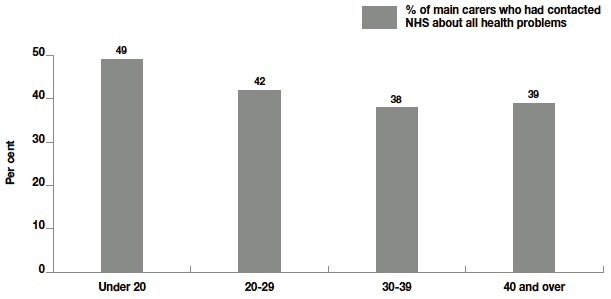
Base: parents who had contacted a health professional about all their child's different health problems since birth - under 20 = 333,
20-29 = 2426, 30-39= 2799, 40 and over = 251
9.3.4 Birthweight and health in the first year of life
The preceding sections presented a range of indicators of early health outcomes. As discussed in chapter 3, one of the earliest markers of poor early health and development is low birthweight. This section briefly presents the associations between low birthweight and general health, long-term conditions and health problems at 10 months.
Figure 9.4 shows that children with a low birthweight were less likely than those with a normal weight to be described by their main carer as having 'very good' health. This was particularly so for boys, to the extent that the general health of normal weight boys and low birthweight girls was in fact very similar. Low birthweight children were almost twice as likely as those with a normal birth weight to have a long-term condition (19% versus 11%). While the absolute level of such conditions was higher in low birthweight boys than girls (24% and 16% respectively) the relative differences, when compared with normal weight children, were similar for both sexes. In contrast, there was only a small difference between low and normal weight boys in the proportion experiencing four or more different health problems in their first year (26% versus 22%), whereas the difference was greater among girls (26% versus 16%).
Figure 9.4 Child general health (at 10 months) by birthweight and sex
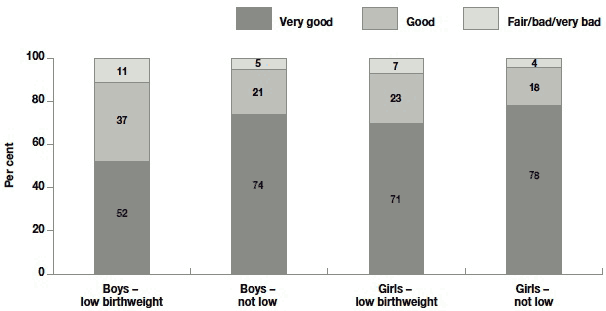
Base - all children: Boys - low birth = 174, not low = 2880; Girls - low birth = 208, not low = 2809
9.4 Accidents
9.4.1 Accident rates
Main carers were asked if their child had received NHS treatment for an accident at any point since their birth, and if so, what kind of injury occurred and whether a hospital visit resulted. In 2010/11, 8% of children (8% of boys and 9% of girls) had received treatment for an accident. This represents a small (but statistically significant) reduction from 2005/06 when 10% of children had done so (11% of boys, 9% of girls). Of those children experiencing accidents requiring treatment, similar proportions in both years had visited casualty or were admitted to a hospital ward (75% in 2010/11, 73% in 2005/06).
Asking about accidents requiring treatment means that, in many cases, it is likely that only the more serious kinds of accidents were reported. However, it is also possible that parents' perceptions of when children require treatment for an accident vary. Some of the differences in accident rates discussed below could, therefore, be due to variations in parental treatment- seeking, rather than differences in accidents happening.
For example, in 2010/11, 13% of children whose mothers were aged under 20 at their birth had experienced an accident resulting in NHS treatment. This declined as maternal age increased, to 6% for children with mothers aged 40 or more. The same pattern was evident in 2005/06. As noted above, younger mothers were the most likely group to have contacted a health professional for all the episodes of illness their child had experienced, so it is possible that younger mothers are also more likely to seek treatment for their child's accident. However, 9% of first born children had received treatment for an accident, compared with 7% of children who were the third or more, which suggests that parental experience alone does not account for the large difference in accident rates by maternal age.
Education level was also unrelated to accident rates - children in households with no qualifications were as likely to have treatment for an accident as those in households with higher education - and other socio-economic status measures such as income and area deprivation were unrelated to accident treatment rates. The differences by family type and ethnic group reported in 2005/06 were not evident in 2010/11.
Analysis of the first GUS birth cohort showed that accidents peaked in the 22-month sweep (Bromley and Cunningham-Burley, 2010), which was attributed to the increasing physical independence children show in their second year of life and the subsequent higher risk of falls and knocks as they learn to walk. These early signs of higher risk coinciding with greater mobility were also evident in the new birth cohort: the minority of children who at 10 months had already started to walk were more likely to have had treatment for an accident than those not yet walking (11% versus 7%).
9.4.2 Hospital treatment for accidents
In addition to knowing whether the children had received any NHS treatment for an accident, it is also possible to identify a further subset of more serious accidents that required a visit to casualty or resulted in a hospital in-patient admission. In-patient admissions were rare, just 5% of children who were treated for an accident were admitted to a ward (0.4% of children overall), so trips to casualty and in-patient admissions have been combined for the following analysis.
Table 9.2 shows that while there was a significant association between maternal age at birth and children ever having received treatment for an accident, the pattern in relation to hospital treatment - although following a similar downward trend - was not statistically significant. Hospital treatment for accidents was not associated with any of the socio-economic status measures, such as area deprivation, or with the child's sex.
Table 9.2 Treatment for accidents by age of mother at birth of cohort child
| Age of mother at birth of cohort child | |||||
|---|---|---|---|---|---|
| Under 20 | 20 to 29 | 30 to 39 | 40 or over | All | |
| Accident treatment | % | % | % | % | % |
| Ever received treatment for an accident** | 13 | 9 | 8 | 6 | 8 |
| Visited casualty or admitted to a ward after an accidentNS | 9 | 7 | 6 | 5 | 6 |
| Base: all children | 343 | 2553 | 2950 | 267 | 6127 |
** = p<.01; NS = not significant [p=0.12]
9.4.3 Injuries resulting from accidents
As Table 9.3 shows, the majority of accidents did not result in a serious injury. By far the most common injury was a knock or fall such as a bump on the head, experienced by 60% of children who had accidents requiring treatment. In contrast, just 1% experienced more severe outcomes such as a broken bone or a cut requiring stitches. The question wording about injuries was not comparable across the two birth cohorts so the results cannot be compared directly.
Table 9.3 Types of injuries resulting from accidents
| Type of injury | % of cases |
|---|---|
| Knock or fall with no serious injury (eg. bang on head) | 60 |
| Other type of accident | 9 |
| Knock or fall resulting in cut or graze | 8 |
| Burn or scald | 7 |
| Knock or fall resulting in bruise, sprain or twist | 4 |
| Dislocation/avulsion | 3 |
| Other knock/fall or non-penetrating accident | 2 |
| Other cut/graze | 2 |
| Injury to face or mouth eg. nosebleed | 2 |
| Something stuck in eye, nose, throat, ear or other body part | 2 |
| Swallowed an object | 2 |
| Swallowed household cleaner/other poison/pills | 1 |
| Knock or fall resulting in broken bone | 1 |
| Knock or fall resulting in cut needing stitches | 1 |
| Choking fit | 1 |
| Animal or insect bite/sting | 1 |
| Base: all children who had an accident requiring NHS treatment | 509 |
9.5 Development of motor skills
Motor skills were assessed in both birth cohorts by asking if children had accomplished the seven specific tasks (or milestones) listed in Table 9.4. They covered 'gross' skills, requiring the coordination of large muscles, such as walking, as well as 'fine' skills which require more precise movements, such as picking up small objects. These kinds of skills are not simply indicative of muscle development; their acquisition is inextricably linked to wider cognitive and emotional development (Adolph and Berger, 2011).
Five milestones were met by over 90% of children in both cohorts, while just under 90% could stand while holding onto something, and around a quarter (23-24%) had walked a few steps on their own. The proportions meeting each milestone were very similar for both boys and girls.
The six motor development milestones met by the majority of children (excluding walking) were analysed further by calculating the total number of these milestones children had achieved or missed. As Table 9.4 shows, slightly fewer children in 2010/11 had missed milestones than in 2005/06. The difference between the proportions missing one or more milestones in 2010/11 and 2005/06 (20% and 17%, respectively) was statistically significant, however, at three percentage points the overall difference was quite small[45].
Table 9.4 Motor milestones by cohort
| Cohort 1 | Cohort 2 | |
|---|---|---|
| Child can… | % | % |
| …pass a toy back and forth from one hand to the other | 99 | 99 |
| …sit without being supported | 99 | 99 |
| …pick up small object with just forefinger and thumb | 97 | 98 |
| …put hands together | 97 | 97 |
| …move about on the floor | 94 | 96 |
| …stand up while holding onto something | 88 | 89 |
| …walk a few steps on their own | 23 | 24 |
| Number of 'majority' milestones missed*** | ||
| 0 | 80 | 83 |
| 1 | 15 | 13 |
| 2 or more | 5 | 4 |
| Base: all children | 5178 | 6094 |
*Bases vary - those shown are for the lowest of the range (the number of milestones missed)
*** = p<.001
The rest of the discussion in this section focuses on the 2010/11 results. Of those children who had missed milestones, problems with gross motor coordination skills were more common than with fine motor coordination. For example, 68% could not stand while holding onto something and 25% could not move about on the floor independently. In contrast, 16% couldn't put their hands together and 12% couldn't pick up a small object between their fingers.
The likelihood of missing milestones was not associated with measures of socio-economic status such as area deprivation or education level of the household. However, as Figure 9.5 shows, the likelihood of missing milestones increased as the number of children in the household increased. Similarly, second and subsequent children were also more likely to have missed milestones than firstborn children. Given these findings, it is therefore unexpected that mothers aged 40 or over at birth were a little more likely to have children who had missed milestones than mothers aged 39 or under. Birthweight was strongly associated with missing milestones, which is likely to reflect longer-term developmental problems associated with prematurity. The number of different health problems children had experienced was not associated with missing milestones.
Figure 9.5 Proportion of children at 10 months who missed one or more motor milestones, by birthweight and number of children in household
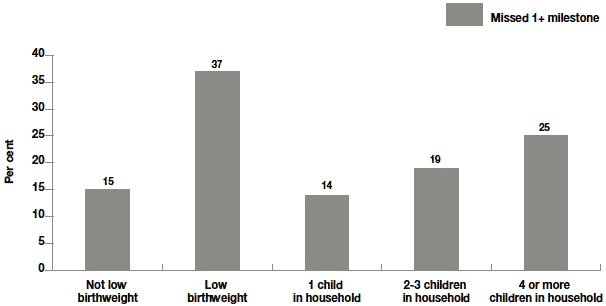
Base - all children: not low birthweight = 382, low birthweight = 5689; 1 child in household = 2803, 2-3 children in household = 3034; 4 or more children in household = 257
9.6 Development of communication skills
New questions about early communication were asked in 2010/11. These were included in the first birth cohort, but not until the children were 22 months old, so no comparisons can be made at this point. The items came from the Communication and Symbolic Behaviour Scale (CSBS) (Wetherby and Prizant, 2001) which has been widely used to assess children's pre-verbal communication skills and includes aspects such as gazing, waving, nodding, pointing with the purpose of obtaining objects (imperative pointing), and pointing to merely draw other people's attention to objects (declarative pointing). Some studies suggest that there is a positive association between these kinds of early symbolic gestures and later language development (Akhtar and Martinez-Sussman, 2007). The direct assessments of vocabulary planned for the next wave of the new birth cohort will be able to explore this further. To avoid the possibility that carers might not want to tell an interviewer if their child cannot do something that most children can, the questions were in the self-completion section.
Table 9.5 presents the proportions of children whose main carers said they displayed each communication or symbolic behaviour type sometimes or often. All but one of the behaviours were displayed by the majority of children, though pointing was less common, and only around a quarter of children could nod to indicate yes. For half of the individual items, girls' communication skills were more advanced than boys - a common finding in most communication research with children - while for the remaining items there were no differences between boys and girls. Main carers also thought that girls knew slightly more words or phrases than boys, though the difference here was not large.
Table 9.5 Communication and symbolic gestures, by sex
| Boys | Girls | |
|---|---|---|
| Child… | % | % |
| …responds by looking/turning if name is called | 99 | 100 |
| …looks at a toy if parent points to it across a room | 95 | 96 |
| …lets parent know if they want an object out of reach | 96 | 95 |
| …picks up objects and gives them to parent | 87 | 92 |
| …waves to greet people | 73 | 86 |
| …shows objects to parent without giving it to them | 82 | 85 |
| …does things just to make parent laugh | 82 | 82 |
| …points to objects | 64 | 73 |
| …gets parent to notice interesting objects (without wanting anything to be done with object) | 59 | 65 |
| …nods head for yes | 21 | 27 |
| Number of words/phrases child knows | ||
| None | 14 | 13 |
| 1-3 | 43 | 38 |
| 4-10 | 34 | 38 |
| 11-30 | 8 | 10 |
| Over 30 | 1 | 1 |
| Bases* | 3023 | 2993 |
*Bases vary - those shown are for the lowest of the range (number of words known)
In contrast to the motor skills development items, some of the communication and symbolic behaviours showed some notable variations across social groups. By way of illustration, Figure 9.6 presents the five behaviours that were significantly associated with area deprivation and compares the proportion of children in the least and most deprived SIMD quintiles who displayed each behaviour. In each case children in the most deprived areas were more likely to display the behaviour than children in the least deprived areas, with the greatest difference evident for affirmative nodding.
As noted above, early symbolic behaviour has been linked with later language development. However, findings from the first GUS cohort, and other similar studies such as the Millennium cohort, show that early language skills are negatively associated with deprivation and low socio-economic status to the extent that by the time children reach school the vocabulary development of those from the lowest income households was 13 months behind the least deprived children, with the gap between children whose parents have a degree and those with no qualifications being 18 months (Bradshaw, 2011). The finding that children from more socio-economically disadvantaged backgrounds have better communication and symbolic behaviour skills at 10 months is therefore potentially surprising (though replicate similar findings from cohort 1). It could be due to the different measurement methods used and the fact that some of the behaviours being asked about (such as declarative pointing) are difficult to assess. While parents are generally capable of accurately reporting their children's development, the direct assessments of vocabulary development used in the first GUS cohort are more accurate, and assess a more readily accessible skill.
Figure 9.6 Selected communication and symbolic behaviours by Scottish Index of Multiple Deprivation quintile
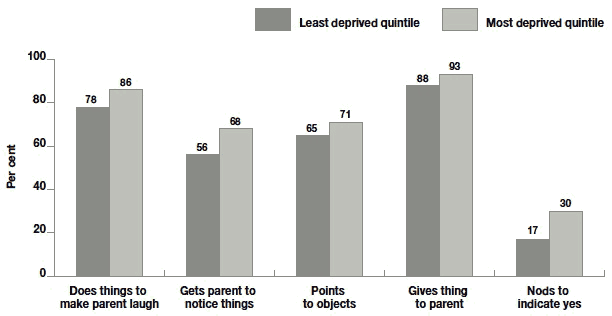
Base - all children: least deprived quintile = 1149, most deprived quintile = 1283. Bases vary - those shown are for the lowest of the range
To enable more detailed analysis, a composite scale was created using all the items in the interview to help identify the children with relatively less and relatively more developed communication and symbolic behaviour skills.
The full set of CSBS items can be used to derive a validated scale which can be used to create clinical thresholds indicating children whose early communicative behaviour warrants further professional assessment. As only a subset of the CSBS items was included in the GUS questionnaire these thresholds cannot be created. However, the individual items could be scored in the same way as the full CSBS scale[46] to create a scale that ranged from zero to 24. The scale's distribution was approximately normal, and had a mean of 14.5 (and a median of 15). The scale was then grouped into four roughly equal groups (quartiles). Children in the first quartile had the lowest scores, and therefore less well developed communication skills, while those in the fourth quartile, with the highest scores, had the most advanced skills.
As would be expected from the results in Table 9.5, girls had higher scale scores than boys. For example, 31% of girls and 22% of boys had scores in the highest quartile, while 19% of girls and 28% of boys had scores in the lowest quartile.
Figure 9.7 shows that the proportion of children in the lowest scoring quartile followed a fairly linear increase as maternal age at birth increased, resulting in children whose mothers were aged 40 and over when they were born being twice as likely as those with mothers under 20 to have the lowest scores (32% versus 15%). In contrast, while one in three children born to mothers under 20 were in the highest scoring quartile, this declined to one in four of those whose mothers were aged 40 and over.
Figure 9.7 Communication and symbolic behaviour scale scores by age of mother at cohort child's birth
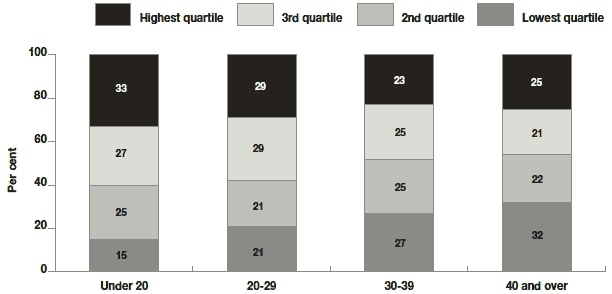
Base - all children with complete CSBS data: under 20 = 295, 20-29 = 2168, 30-39 = 2481, 40 and over = 222
Table 9.6 presents a wider range of factors found to be associated with CSBS scale scores. Compared with the average child, early communication skills were less well developed if a child was not a mother's firstborn, if they lived in the least deprived areas, and if they had a main carer from an ethnic group other than white. This latter finding may, in part, reflect differences in how the questions were interpreted by parents from other ethnic backgrounds.
The results also show how early motor development and communication skills are related - many of the symbolic behaviours are dependent on children having reached a certain level of motor coordination (eg. being able to point or wave) so it is unsurprising that the children showing motor delays had lower CSBS scores. However, it is perhaps worth highlighting that missing just one of the milestones was associated with notably lower CSBS scores; it wasn't simply the case that children with the most significant motor delays had poorer communication skills. Although a small group in the population overall, those children with both motor and communication development delays are likely to require enhanced monitoring in their early years, and intervention where beneficial. Linked to this, the impact of low birthweight on later development is clear, with low birthweight children almost twice as likely to have low CSBS scores as those with a normal birthweight. The number of different health problems children experienced in their first 10 months was unrelated to CSBS scores.
An exploratory logistic regression model was run to investigate the factors independently associated with children being in the lowest CSBS quartile (with the least well-developed communication skills), once other factors were controlled for at the same time. It showed that maternal age at birth and household education were not associated with being in the lowest group, but that all the items presented in Table 9.6 remained significantly associated.
Table 9.6 Communication and symbolic behaviour scale scores by selected key variables
| CSBS scale score | |||||
|---|---|---|---|---|---|
| Lowest quartile (<12) | 2nd quartile (12-14) | 3rd quartile (15-17) | Highest quartile (>18) | Base: All children with complete CSBS information | |
| Total % | 24 | 23 | 27 | 26 | 5178 |
| Birth order of cohort child*** | |||||
| Firstborn% | 20 | 22 | 28 | 30 | 2506 |
| Second born% | 26 | 25 | 26 | 23 | 1767 |
| Third born% | 30 | 24 | 24 | 22 | 677 |
| Fourth born or more% | 30 | 23 | 25 | 23 | 228 |
| Ethnicity of main carer*** | |||||
| White% | 23 | 23 | 27 | 27 | 4951 |
| Other ethnic group% | 35 | 29 | 20 | 16 | 217 |
| SIMD*** | |||||
| Least deprived quintile% | 30 | 23 | 24 | 23 | 980 |
| 2nd% | 27 | 23 | 27 | 23 | 1007 |
| 3rd% | 22 | 24 | 28 | 27 | 1081 |
| 4th % | 22 | 23 | 28 | 27 | 1036 |
| Most deprived quintile% | 19 | 23 | 27 | 30 | 1073 |
| Number of motor milestones missed*** | |||||
| None% | 19 | 23 | 29 | 29 | 4320 |
| One% | 40 | 27 | 20 | 14 | 660 |
| Two or more% | 66 | 19 | 12 | 2 | 178 |
| Birthweight*** | |||||
| Low (<2500g)% | 42 | 19 | 21 | 17 | 316 |
| Not low (>2500g)% | 22 | 24 | 27 | 27 | 4840 |
*** = p<.001
9.7 Parental knowledge of child development
The preceding two sections looked at children's motor and communication development, as assessed by their main carers. To help explore the association between parental knowledge of child development and child outcomes the interview included a series of knowledge questions about motor skills, communication and socio-emotional development. It is possible, for example, that if parents have low expectations or awareness of what a child can do at certain stages that this could affect their interactions with their child and, consequently, result in slower development. Additionally, with limited universal reviews of child development (from April 2013 these will be introduced at 27-30 months), delays in development are largely identified via parents reporting concerns. If knowledge of what should be expected of children is low, then this might result in developmental delay being unrecognised.
Figure 9.8 shows the percentage of main carers who correctly answered each question (whether the statement was true or false is also shown). For the items that were false, main carers also had to say whether a child would need to be older or younger to complete the task. For example, only those who said that a baby would be older than six months before saying their first real word was judged to have given a correct answer. With the exception of the question about the age at which babies can reach for objects, a clear majority of main carers answered each item correctly. Knowledge was highest in relation to the amount of sleep children need and whether a 1 year old can remember a hidden toy.
Figure 9.8 Main carers' knowledge of early child development (% giving correct answer)
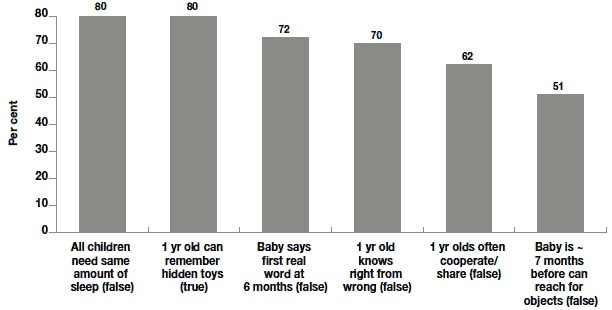
Base - all parents, n = 6119
A scale of parental knowledge was created. One point was given for each correct item and one point was deducted for each incorrect item. No points were given (or deducted) for non-committal answers (eg. don't know, not sure). Scores therefore ranged from -6 to 6. The scale was not normally distributed, the mean score was 2.6, while the modal (most common) score was 4 (27% of main carers achieved this). At the extremes of the distribution, just 8% had scores below zero, 12% scored zero, and 14% got the highest score, by answering all six items correctly.
To compare levels of knowledge the scores were grouped as follows: 1 or less (least knowledgeable), 2-3, 4, and 5-6 (most knowledgeable). As Table 9.7 shows, levels of knowledge showed clear social patterns. Main carers in households with no qualifications or education classified as 'other' - which includes many international qualifications - had the lowest levels of knowledge with the proportion in the least knowledgeable group declining in a stepwise fashion as education increased. Main carers from ethnic groups other than white had lower child development knowledge levels than the rest of the population, as did those living in the most deprived areas. Interestingly, knowledge increased as maternal age increased, but was lower among carers whose child was their fourth or subsequent than among those with first- to third born children.
Table 9.7 Knowledge of early child development
| Developmental knowledge group | |||||
|---|---|---|---|---|---|
| Least knowledgeable quartile (1 or less) |
2nd quartile (2-3) | 3rd quartile (4) | Most knowledgeable quartile (5-6) | Base: all families | |
| Total % | 26 | 30 | 27 | 18 | 6127 |
| Education level of household*** | |||||
| No qualifications% | 43 | 30 | 19 | 8 | 281 |
| Other (inc international)% | 63 | 26 | 8 | 2 | 96 |
| Lower level standard grades% | 40 | 32 | 19 | 9 | 261 |
| Higher level standard grades% | 32 | 31 | 23 | 13 | 1000 |
| Higher grades% | 25 | 31 | 29 | 16 | 1730 |
| Degree% | 17 | 29 | 31 | 23 | 2618 |
| Ethnicity of main carer*** | |||||
| White% | 25 | 30 | 28 | 18 | 5813 |
| Other ethnic group% | 46 | 30 | 18 | 7 | 299 |
| SIMD*** | |||||
| Least deprived quintile% | 18 | 28 | 32 | 22 | 1155 |
| 2nd% | 23 | 28 | 28 | 21 | 1175 |
| 3rd% | 24 | 31 | 30 | 14 | 1273 |
| 4th % | 29 | 31 | 24 | 16 | 1235 |
| Most deprived quintile% | 31 | 32 | 23 | 14 | 1288 |
| Maternal age at birth*** | |||||
| Under 20% | 36 | 32 | 21 | 11 | 343 |
| 20-29% | 29 | 31 | 25 | 16 | 2553 |
| 30-39% | 21 | 30 | 30 | 20 | 2950 |
| 40 and over% | 23 | 28 | 28 | 20 | 267 |
| Birth order of cohort child** | |||||
| Firstborn% | 27 | 31 | 26 | 17 | 2925 |
| Second born% | 23 | 29 | 29 | 19 | 2119 |
| Third born% | 26 | 31 | 27 | 16 | 804 |
| Fourth born or more% | 33 | 29 | 25 | 13 | 279 |
*** = p<.001, *** = p<.01
Figure 9.9 shows that there was no evidence of an association between knowledge and children's achievement of motor milestones, and while there was an association with communication and symbolic behaviour, the children with the most knowledgeable carers actually had lower scores compared with those with the least knowledge. This is unsurprising, as the social profile of children with the least well developed communication skills was relatively advantaged, which matches the profile of the most knowledgeable main carers. The regression analysis of CSBS scores included parental knowledge and this association was found to be significant, even after controlling for the other factors shown in Table 9.6. These results do not, therefore, appear to support the hypothesis that levels of child development knowledge positively enhance these outcomes.
Indeed, it is also possible that the behaviour of parents who overestimate what a young child can do may have a positive influence by transmitting high expectations. Or, it might be the case that parents of children experiencing delayed development become more knowledgeable of what a child should be able to do, as a consequence of discussing concerns about their child's progress with professionals.
Systematic reporting error of the motor milestones or CSBS items might also have contributed to the lack of association if parents with low levels of knowledge over estimated what their children could do, either through error or social desirability bias. Similarly, parents with high knowledge levels may have underestimated their children's abilities. The use of self-completion methods should have helped to reduce socially desirable answers, but without direct assessments, other forms of reporting error cannot be ruled out. It was noted above that some of the CSBS items address quite complex behaviours, though the motor milestones are more straightforward so should arguably be less prone to this kind of error.
The final point to stress is that while these results show no association between knowledge and outcomes, it is possible that more detailed and/or sensitive measures of both aspects may well show an association. Direct assessments of the children will be carried out at the next sweep of the study, so these early knowledge items can be assessed again to see if they are associated with later developmental outcomes. Though, if the greatest concern lies with the accuracy of parental reporting, then this has practice implications: the guidance for the new 27-30 month reviews starting in April 2013 include a number of tools that rely on parental reports, rather than direct assessments.
Figure 9.9 Motor milestones and communication and symbolic behaviour scale scores by main carers' knowledge of early child development
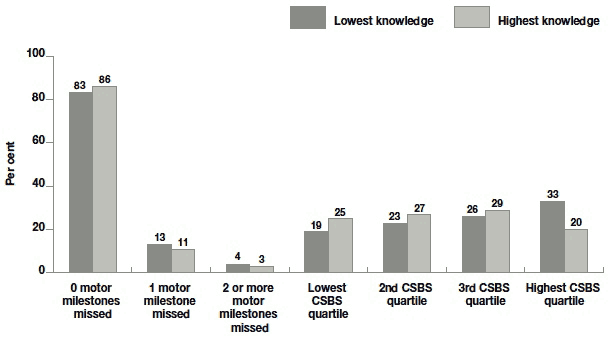
Base - all children: Milestones missed - lowest knowledge = 1530, highest knowledge = 1071; CSBS quartiles - lowest knowledge = 1254, highest knowledge = 900
9.8 Parental concerns about development
The interview included questions to tap main carers' concerns about their child's development in three broad areas: development, learning and behaviour; communication; gross and fine motor skills[47]. The first area was also asked about in 2005/06, the latter two were only asked in 2010/11.
The overall prevalence of parental concerns was quite low: just 5% of main carers in 2010/11 reported some or a lot of concerns about their child's development, learning or behaviour. This was a reduction from the 8% registering such concerns in 2005/06. Concerns about communication or motor skills were less common, each were mentioned by just 2% of main carers (though it is likely that some carers' concerns about these areas will have been captured by the first, more general question). In total, combining all three areas of development covered, 6% of main carers in 2010/11 had concerns in one or more of the domains.
Although girls had more advanced communication skills than boys (see section 9.6), the prevalence of developmental concerns did not vary significantly by the children's sex, or by maternal age at birth, or birth order. The prevalence of developmental concerns was, however, associated with socio-economic status. For example, 9% of carers in the lowest household income quintile had concerns compared with 4% in the two highest quintiles. The association with area deprivation was significant, but not linear, with concerns most prevalent in the fourth most deprived quintile (9%) and lowest in the least deprived quintile (4%). Prevalence of concerns was higher in households where the highest qualification obtained was at standard grade level or below (7%-9%) than in households obtaining degrees or higher grades (4%-6%).
As Figure 9.10 illustrates, there was a marked association between the achievement of motor milestones and parental concerns: 4% of main carers whose children had met all of the six motor milestones (as described above in section 9.5) reported developmental concerns, rising to 34% for children missing two or more milestones. In contrast, while there was an association between CSBS scores and reported concerns, the difference in the prevalence of concerns between carers whose children were in the lowest and highest scoring groups was much smaller (10% versus 4%). This possibly suggests that delays in motor skill development are more apparent to carers and therefore trigger concerns more readily than problems with communication skills. The fact that the majority of carers of children who had not met the milestones achieved by their peers did not register any concerns about their child's development does not necessarily mean that problems are going unnoticed. The windows within which children meet milestones are quite wide, so the fact that a child has not met them all by 10 months does not in itself indicate a problem.
Figure 9.10 Proportion of carers with concerns about their child's development, by number of motor milestones missed and communication and symbolic behaviour scale scores
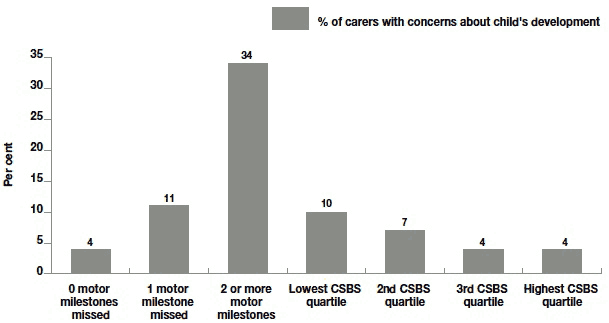
Base - all children: 0 milestones missed = 5085, 1 milestone missed = 791, 2 or more milestones missed = 218; lowest CSBS quartile = 1228, 2nd CSBS quartile = 1204, 3rd CSBS quartile = 1393, highest CSBS quartile = 1353
It is perhaps more useful to look at this from the opposite perspective - what proportion of children whose carers expressed no concerns about their development missed motor milestones or had relatively less well developed communication skills? Just 15% of children whose carers expressed no concerns about their development had missed one or more motor milestones, compared with 44% of children whose carers had some concerns. Similarly, as Figure 9.11 shows, the CSBS scores of children whose carers had no concerns were roughly evenly distributed across the four groups whereas two-thirds of children whose parents expressed concerns were in the two lowest scoring CSBS groups.
We cannot conclude from these two sets of findings that parents are necessarily missing developmental delays in their children - as stressed above, missing a motor milestone at
10 months does not automatically mean there is a problem, while these early communication behaviour patterns are not meant for use as diagnostic tools - but it does seem clear that parental concerns are more likely to be triggered by potential delays in communication than in motor skills. The power of these early measures to predict later delayed outcomes can be assessed as the children age.
Figure 9.11 Communication and symbolic behaviour scale scores by parental concerns about development
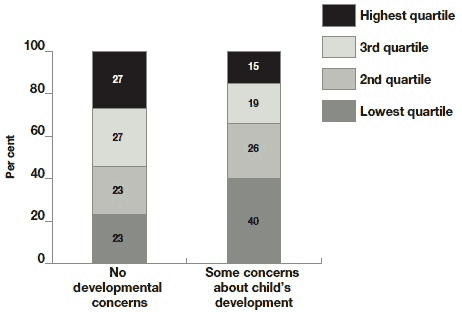
Base - all children: No concerns = 5755, some concerns = 365
Figure 9.12 investigates whether parents who said they had no concerns about their child's development despite having low CSBS scores were less knowledgeable about development than parents of similarly able children who did have concerns. It shows that knowledge levels did not differ markedly between the two groups, and that, if anything, for this particular group of parents, those with no developmental concerns were somewhat more knowledgeable than those with some concerns.
Figure 9.12 Knowledge of child development by parental concerns about development, among children with the lowest CSBS scores
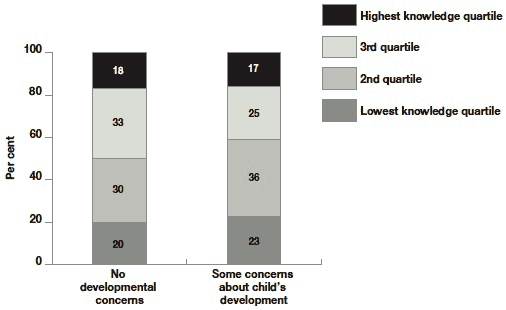
Base - all children: No concerns = 5755, some concerns = 365
9.9 Sleep
In both cohorts just under half of children were reported to be sleeping through the night on every night of the week (48% BC1, 46% BC2), while one in five (20%/21%) never did this. The mean number of hours children were reported to sleep in a typical 24-hour period (including daytime naps) was also similar in both years (13.0 in 2010/11 and 12.9 in 2005/06). Also, 8% of main carers in both cohorts said that their child's sleep had been a big problem for them in the preceding three months, with a further one in four (25% in 2005/06 and 28% in 2010/11) describing it as a bit of a problem, and around two-thirds (67% in 2005/06 and 64% in 2010/11) saying their child's sleep had not been a problem for them at all[48].
The rest of the discussion focuses on the 2010/11 results. There was a close correspondence between reported problems with sleep and both children's sleeping patterns and their mean hours of sleep. Figure 9.13 shows that, as might be expected, the likelihood of carers reporting problems with their child's sleep reduced notably as the frequency of the child sleeping through the night increased. The mean number of hours children slept each day increased in line with the number of full nights' sleep reported each week, from 12.2 hours for children who never slept through the night to 13.4 hours for those reported to do so every night. This suggests that children with interrupted sleep at night do not make up for this lost time via daytime naps. Children whose sleep was described as a big problem in past three months slept for a mean of 11.7 hours a day, this increased to 12.7 for children whose sleep was described as a bit of a problem, and 13.2 hours for those whose sleep was not a problem at all.
Figure 9.13 Proportion of carers reporting problems with child's sleep in past three months by number of times child sleeps through the night each week
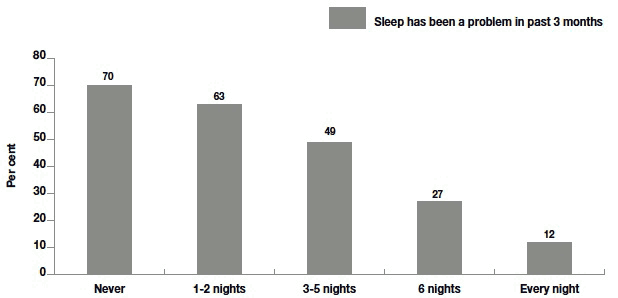
Base - all children: never = 1302, 1-2 nights = 592, 3-5 nights = 771, 6 nights = 638, Every night = 2822
Table 9.8 presents the proportions of children who never slept through the night, and those doing so every night, as well as the mean hours of sleep per day, and the proportion of carers reporting any recent sleep problems, by a range of socio-demographic factors. It illustrates how the correspondence between sleeping patterns, duration, and problems noted above was not consistently evident across social groups.
For example, although children born to mothers aged under 20 were the most likely to be sleeping through the night (and the least likely to never do this), and were least likely to have their sleep described as problematic, their sleep duration was, at 12.8 mean hours, lower than for children born to mothers aged 20-39, even though children in these groups were less likely to always sleep through the night. In fact, children born to mothers aged under 20 slept for the same number of hours per day as those born to the oldest mothers who were much more likely to report problems with sleep and say their child never slept through the night.
Another example of a potential discordance between sleeping patterns and reported problems is evident among main carers from non-white ethnic groups. Children with non-white carers were less likely to sleep through the night than children with white main carers (33% versus 21%) and their sleep duration was shorter (12.6 versus 13.0 mean hours), however, the proportions describing their child's sleep as problematic were not significantly different (38% and 36%, respectively). Perhaps the most extreme example of this type of discordance is illustrated by the results by area deprivation quintile. Sleep patterns and reported problems did not vary significantly by area deprivation, despite the fact that the mean number of hours children slept per day decreased as deprivation increased, from 13.3 hours in the least deprived areas to 12.6 in the most deprived areas.
Table 9.8 Sleep patterns, duration and reported problems by selected key characteristics
| Sleep measures | |||||
|---|---|---|---|---|---|
| Never sleeps through night | Sleeps through night every night | Mean hours of sleep in 24-hr period | Child's sleep has been a problem in last 3 months |
Base: all families | |
| Total % | 21 | 46 | 12.9 | 36 | 6118 |
| Maternal age at birth | ** | *** | *** | ||
| Under 20% | 14 | 58 | 12.8 | 28 | 342 |
| 20-29% | 21 | 47 | 12.9 | 34 | 2547 |
| 30-39% | 23 | 43 | 13.1 | 38 | 2948 |
| 40 and over% | 21 | 41 | 12.8 | 39 | 267 |
| Number of children in household | *** | NS | * | ||
| One% | 18 | 49 | 13.0 | 35 | 2809 |
| Two or three% | 24 | 44 | 13.0 | 37 | 3052 |
| Four or more% | 28 | 41 | 12.7 | 29 | 257 |
| Education level of household | ** | *** | ** | ||
| No qualifications% | 27 | 43 | 12.3 | 32 | 281 |
| Other (inc international)% | 32 | 32 | 12.8 | 34 | 95 |
| Lower level standard grades% | 21 | 48 | 12.5 | 37 | 259 |
| Higher level standard grades% | 22 | 50 | 12.7 | 33 | 997 |
| Higher grades% | 19 | 49 | 13.0 | 34 | 1729 |
| Degree% | 22 | 43 | 13.3 | 39 | 2617 |
| Ethnicity of main carer | *** | ** | NS | ||
| White% | 21 | 47 | 13.0 | 36 | 5806 |
| Other ethnic group% | 33 | 33 | 12.6 | 38 | 298 |
| SIMD*** | NS | *** | NS | ||
| Least deprived quintile% | 20 | 43 | 13.3 | 39 | 1155 |
| 2nd% | 21 | 45 | 13.2 | 37 | 1173 |
| 3rd% | 23 | 46 | 13.1 | 35 | 1273 |
| 4th % | 21 | 47 | 12.8 | 36 | 1231 |
| Most deprived quintile% | 21 | 47 | 12.6 | 33 | 1285 |
Bases vary, those shown are for the lowest of the range (mean hours of sleep)
*** = p<.001, ** = p<.01, * = p<.05, NS = not significant
9.10 Dental health
Parents are advised to start tooth brushing with fluoride paste as soon as a child's first tooth appears, and to visit a dentist at least twice a year. Brushing is recommended last thing at night as well as at least once during the day[49]. In 2010/11, 92% of children had at least one tooth. Whether a child had any teeth did not show much socio-demographic variation, with one notable exception: 14% of children with non-white main carers did not have any teeth compared with 7% of those with carers from white ethnic groups. The rest of the following discussion focuses on teeth brushing habits which, by definition, excludes children without teeth.
Main carers were asked how often their child's teeth were brushed with fluoride toothpaste; the answer options were more than once a day (in line with the recommended practice), once a day, and less than once a day. Almost half (46%) of children have their teeth brushed more than once a day, 38% have them brushed once a day, while 16% are brushed less than once a day.
By the time children reach school, dental health shows quite marked socio-economic patterns. For example, in 2010, 45% of primary 1 children in the most deprived 10% of areas were free of dental decay compared with 82% of their counterparts in the least deprived 10% of areas (NHSScotland, 2011). It is therefore interesting that frequency of brushing did not vary by area deprivation, in fact the proportion of children whose teeth were brushed more than twice a day was the same (47%) in the most and least deprived quintiles, as was the proportion whose teeth were brushed less than once a day (16%). There were, however, other socio-demographic differences of note.
Figure 9.14 Frequency of tooth brushing with fluoride paste, by number of children in the household
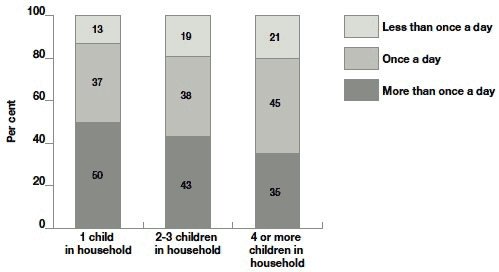
Base - all children with teeth: 1 child in household = 2601, 2-3 children in household = 2808, 4 or more children in household = 237
For example, Figure 9.14 shows that the proportion of children having their teeth brushed every day dropped from half in single child households to a third in households with four or more children. In addition, Table 9.9 shows that the frequency of tooth brushing was significantly associated with ethnicity, education and household income. Children with non-white main carers, in households with lower levels of education, and in the lowest income households have their teeth brushed less often than the average child.
Table 9.9 Teeth brushing patterns
| Frequency of tooth brushing with fluoride paste | ||||
|---|---|---|---|---|
| More than once a day | Once a day | Less than once a day | Base: All children with teeth | |
| Total % | 46 | 38 | 16 | 5646 |
| Ethnic group of main carer*** | ||||
| White% | 46 | 38 | 15 | 5377 |
| Other% | 32 | 33 | 35 | 255 |
| Education level of household*** | ||||
| No qualifications% | 33 | 44 | 23 | 266 |
| Other (inc international)% | 28 | 36 | 36 | 89 |
| Lower level standard grades% | 44 | 37 | 19 | 232 |
| Higher level standard grades% | 45 | 39 | 16 | 928 |
| Higher grades% | 47 | 39 | 15 | 1578 |
| Degree% | 48 | 37 | 16 | 2422 |
| Household income** | ||||
| Bottom quintile (<£10,833)% | 42 | 40 | 18 | 1052 |
| 2nd% | 44 | 37 | 19 | 945 |
| 3rd% | 46 | 38 | 16 | 754 |
| 4th % | 47 | 39 | 14 | 1265 |
| Top quintile (>£40,625)% | 49 | 38 | 14 | 977 |
*** = p<.001, ** = p<.01, * = p<.05.
Note: the difference in the % brushing more than once a day by household income was not significant, however the difference in the % brushing less than once a day was
9.11 Temperament
The second birth cohort introduced some new measures of children's temperament based on assessments made by the people conducting the interviews. Following training about how to make such assessments, interviewers recorded the degree of each child's positive or negative responses to either their carer or the interviewer during the interview (based on the number of displays of positive or negative behaviour), and rated the child's level of anxiety using a 5-point scale ranging from 'not at all shy or anxious' to 'extremely shy, quiet or withdrawn'.
Interviewer observations were completed for 79% of children in the cohort, the remaining cases being where the child was not present during the interview. Interviewer observations were equally likely to have been made of boys and girls, however, children from more advantaged homes were less likely to have been observed. For example, observation data was collected for 85% of children in the most deprived areas compared with 72% of those in the least deprived areas. In a similar vein, 87% of children born to mothers under 20 were observed, which declined to 76%-78% of those born to mothers aged 30 and over. This is likely to have been caused by a higher proportion of interviews with carers from more affluent backgrounds being conducted in the evenings when children were in bed, to fit round working patterns (children with full-time working mothers were less likely to have been observed). It is difficult to quantify the extent to which these variations in observation rates will have biased the estimates of child temperament, but based on evidence from the first birth cohort about children's socioemotional development which showed that conduct disorder is less common in children from more advantaged social groups (Bromley and Cunningham-Burley, 2010), it is likely that some bias will have been introduced.
Figure 9.15 shows that positive behaviour was more likely to be displayed during the interview than negative behaviour, and that where negative mood was in evidence, this was generally confined to a small number of brief displays. And while just under half (47%) of children were described by the interviewers as not at all anxious or shy, at the other end of the scale, only 6% were judged to be moderately or extremely shy.
Figure 9.15 Number of displays of positive or negative mood during interview
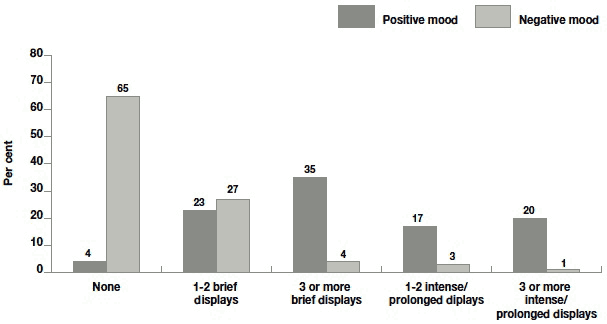
Base - all children where observations completed, n = 4840
The questionnaire included a number of measures of carers' mental health (eg. the SF12 - see chapter 10) and feelings about parenthood, such as their levels of patience or feelings of irritation when spending time with their child, feelings of confidence as a parent, and resentment about sacrifices made to be a parent (see chapter 5). Evidence from the first birth cohort showed that children whose mothers had low levels of mental wellbeing had poorer health and developmental outcomes (Marryat and Martin, 2010). There did not, however, appear to be any associations between interviewer observed levels of child anxiety at 10 months and their carers' mental wellbeing or feelings about parenthood. For example, 46% of children whose carers reported feeling annoyed or irritated when they were with their child at least occasionally were judged to be not at all anxious or shy, as were 48% of children whose carers said they had feelings of irritation only very rarely, or never. Similarly, the number and intensity of children's positive mood displays did not vary by carers' mental wellbeing or feelings about parenthood.
9.12 Summary
At 10 months of age, most children in Scotland are deemed by their parents to be healthy. In fact, 95% are said to have good or very good health. This position has not changed since 2005/06 when the corresponding figure was 94%. Similar levels of long-standing conditions or illness were also reported in both cohorts. Neither have the inequalities associated with child health much changed. As has been shown, on these, and a number of other measures, children in more disadvantaged circumstances report poorer health than those in advantaged circumstances.
Most parents had contacted someone about their children's health problems: 40% made contact about all of them, 45% about some of them, and just 14% said they had not contacted anyone. Patterns of contact in some way contrast with the discussion of use of formal support provided in chapter 5. Data here showed that mothers in the youngest group were more likely than older mothers to say they had contacted a professional about all their child's health problems. Yet in chapter 5, younger mothers were shown to be generally less comfortable than older mothers engaging with formal support and more likely to perceive a stigma attached to seeking that support. The findings here suggest that this perception may vary dependent upon the type of support or advice being sought.
The association between low birthweight and later poorer health continues. Children with a low birthweight were less likely than those with a normal weight to be described by their main carer as having 'very good' health and were more likely to have a long-standing condition and to have experienced four or more different health problems since birth. Low birthweight was also found to be associated with a number of other health outcomes.
Child accidents have been the subject of a number of targeted campaigns as noted in the introduction. GUS data shows a small, but statistically significant decrease in the proportion of 10-month old children who had received treatment for an accident. This is in line with similar decreases (for children over a wider age range) shown in data from the Scottish Health Survey and in ISD data on hospital admissions and deaths of children due to accidents (Bradshaw, 2012).
The acquisition of early motor skills has been linked to wider cognitive and emotional development (Adolph and Berger, 2011). Of the seven motor development milestones covered, five milestones were met by over 90% of children in both cohorts. Although statistically significant, the difference between the proportions missing one or more milestones in 2010/11 and 2005/06 (20% and 17%, respectively) was quite small. The likelihood of missing milestones was not associated with measures of socio-economic status but birth weight was, which is likely to reflect longer-term developmental problems associated with prematurity.
A great deal of policy and practice efforts are being made to promote the importance of, and encourage, interaction with babies and toddlers to help their cognitive and social development. GUS data on pre-verbal communication skills shows that all but one of the behaviours covered were displayed by the majority of children. Some significant variations were observed by socio-economic characteristics though perhaps not in the direction expected. For example, children in the most deprived areas were more likely to display the behaviour than children in the least deprived areas. The reasons for this pattern is unclear but may be related to the subjective nature of the items in contrast to the more objective assessments of vocabulary development which will occur at later sweeps.
However, the results do show how early motor development and communication skills are related - children showing motor delays had lower communication scores. Although a small group in the population overall, those children with both motor and communication development delays are likely to require enhanced monitoring in their early years, and intervention where beneficial. Linked to this, the impact of low birth weight on later development is clear, with low birthweight children almost twice as likely to have low CSBS scores as those with a normal birthweight.
Most parents demonstrated a reasonable knowledge of early child development, being able to correctly respond to statements about child behaviour in the first few years of life. However, it is clear that knowledge is lower amongst some groups including parents with lower educational qualifications, younger mothers, those from minority ethnic backgrounds, and those living in more deprived areas. It would appear, therefore, that efforts to improve parenting knowledge of early development through classes, seminars and other resources is warranted. With parents remaining a key source of early identification of developmental delays, improving this knowledge should lead to better early identification of problems and intervention to address them.
It is clear that many parents recognise developmental delay. Concerns about development were significantly higher amongst parents whose children were reported to have missed two or more developmental milestones. The fact that the majority of carers of children who had not met the milestones achieved by their peers did not register any concerns about their child's development does not necessarily mean that problems are going unnoticed; the age range within which children meet milestones are quite wide. Nevertheless, there is some suggestion that some delays may be getting missed by parents.
Almost half (46%) of children have their teeth brushed more than once a day, 38% have them brushed once a day, while 16% are brushed less than once a day. There were no significant variations in teeth brushing behaviour by area deprivation despite NHS data indicating large variations in dental decay amongst children from more and less deprived areas in primary 1. However, children with a larger number of siblings, those in minority ethnic households and those whose parents had lower levels of education had their teeth brushed less often than the average child.
9.13 References
Adolph, K. and Berger, S. (2011). Chapter 5: Physical and motor development. In Bornstein, M. and Lamb, M. Developmental Science - An advanced textbook. Sixth Edition. New York: Psychology press.
Akhtar, N. and Martinez-Sussman, C. (2007). Chapter 8: Intentional communication. In Brownell, C. A. and Kopp, C. B. Socioemotional Development in the Toddler Years. New York: The Guildford Press.
Bradshaw, P. (2012) "Accidents" in Rutherford, L., Sharp, C. and Bromley, C. (Eds) The Scottish Health Survey 2011: Volume 2 - Children, Edinburgh: National Statistics
Bradshaw P. (2011). Growing Up in Scotland: Changes in cognitive ability in the pre-school years. Edinburgh: Scottish Government.
Bromley, C. and Cunningham-Burley, S. (2010). Growing Up in Scotland: Health inequalities in the early years. Edinburgh: Scottish Government.
Irwin LG, Siddiqi A, Hertzman C. (2007). Early Child Development: A Powerful Equalizer. Vancouver: Human Early Learning Partnership.
Kelly, Y., Kelly, A. and Sacker, A. (2011). Time for bed? The relationship between bedtimes and socioemotional and cognitive development in 7 year old children: findings from the UK Millennium Cohort Study. Journal of Epidemiology and Community Health, 65(2): 39-40.
Marryat, L. and Martin, C. (2010). Growing Up in Scotland: Maternal mental health and its impact on child behaviour and development. Edinburgh: Scottish Government.
McCain M and Mustard F. (1999). Early Years Study: Reversing the Real Brain Drain Final Report. Toronto: Ontario Publications.
Scottish Government. (2012). The Scottish Child Health Programme - Guidance on the 27-30 month child health review. Edinburgh: Scottish Government. Available at:
http://www.scotland.gov.uk/Resource/0041/00410922.pdf
Scottish Government. (2010). CEL 15. Refresh of Health for All Children (HALL 4) - Reinforcing the key messages. Edinburgh: Scottish Government. Available at:
http://www.sehd.scot.nhs.uk/mels/CEL2010_15.pdf
Wetherby, A. & Prizant, B. (2001). Communication and Symbolic Behavior Scales Developmental Profile- Preliminary Normed Edition. Baltimore, MD: Paul H. Brookes Publishing Co.
Contact
Email: Sharon Glen
There is a problem
Thanks for your feedback